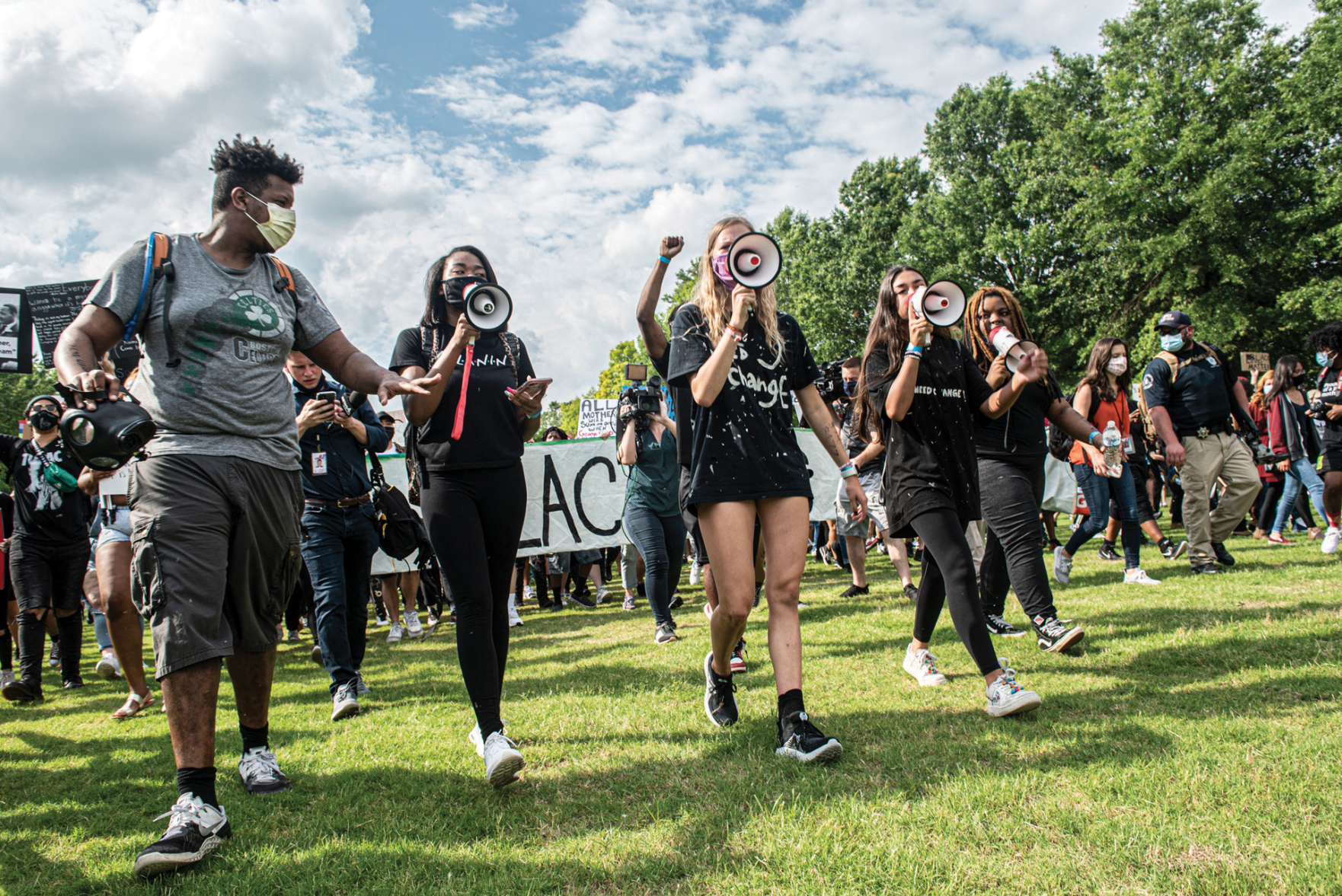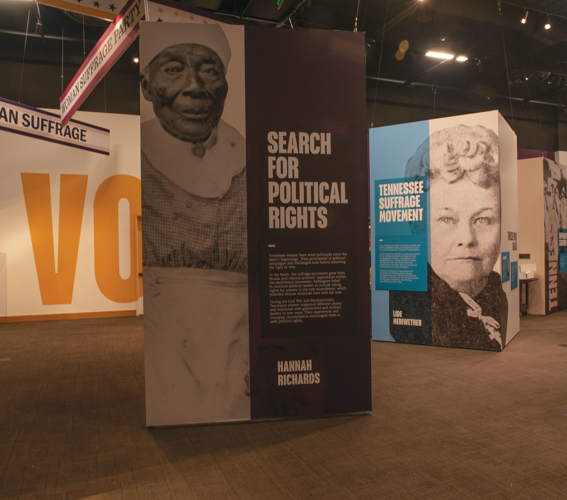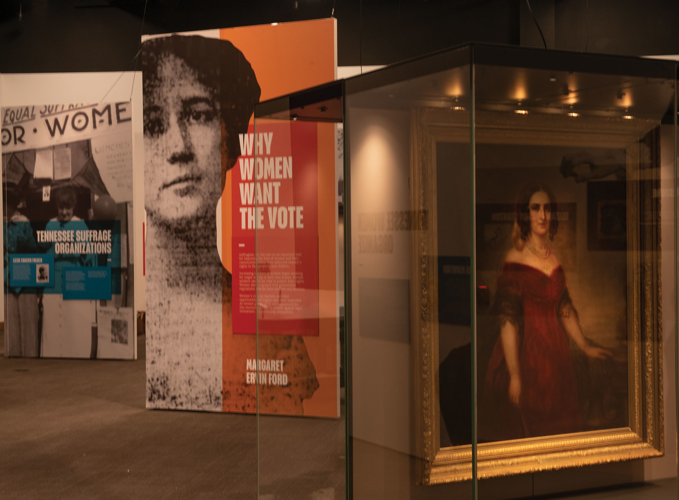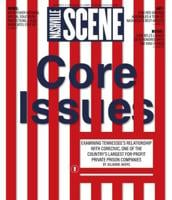
On June 4, more than 10,000 people marched from Bicentennial Capitol Mall State Park to the state Capitol bearing a Black Lives Matter banner and signs memorializing George Floyd and Breonna Taylor — two Black Americans who had recently been killed by police. The protesters made speeches, read poetry and met police clad in riot gear who were stationed outside bars and restaurants on Lower Broadway.

Emma Rose Smith (center) at the June 4 Teens for Equality rally
The peaceful protest was organized by six teen girls: Nya Collins, Jade Fuller, Kennedy Green, Emma Rose Smith, Mikayla Smith and Zee Thomas.
“I wanted to support my friends and be a good ally,” says 15-year-old Emma Rose. “I recognize that racial injustice is a thing, and I wanted to use my voice to lift up the POC community — their voices.”
Calling themselves Teens for Equality, the group planned a second event for July 4, which brought out thousands once again. For Nashvillians, the young women brought a sense of triumph and hope during a year marked by a destructive tornado, a global pandemic and civil unrest.
The teens are continuing a centuries-long tradition of Tennessee women claiming public space. This month, our nation celebrates the centennial of the historic ratification of the 19th Amendment, which gave women the right to vote, sit on juries and run for public office across the country. The deciding vote occurred right here in Nashville, when suffragists from Shelby County to Johnson County convened alongside national leaders to make the final push for a federal amendment. This week, the Tennessee State Museum opens Ratified! Tennessee Women and the Right to Vote, a comprehensive exhibition that details the rich history of women’s activism.
The famous part of the Tennessee story centers on the arrival of Carrie Chapman Catt, director of the National American Woman Suffrage Association, in Nashville. Coordinating with our state’s suffragists (known as the Suffs) and keeping a close eye on the detractors (known as the Antis), Catt engineered the final weeks of the movement from her room at the Hermitage Hotel. In the end, it was Harry T. Burn, a young lawmaker from McMinn County, who cast the decisive vote on Aug. 18, 1920. Swayed by a letter from his mother Febb Burn, Rep. Burn voted for ratification, surprising the Suffs and Antis alike.
But before national organizers came to Nashville, Tennessee women had been campaigning for suffrage for decades.

“I really wanted to look at women and their participation in public life broadly,” says Miranda Fraley-Rhodes, the curator of Ratified! “The story of the suffrage movement to me is just so much more meaningful if you consider the context of women’s activity — how they were connecting with their communities and with their governments starting early in the state’s history, early in the nation’s history.
“We look at how women’s intersections with public life and with government impacted their worldviews, from women with lots of different perspectives, and my hope is that we show why women wanted the vote,” Fraley-Rhodes continues. “I don’t think the answer to that question should ever be assumed, so we really lay the groundwork for that.”
Instead of creating a linear path with the exhibit, the museum opted for a more exploratory approach — which also lends itself well to social distancing. Visitors can move through the two expansive galleries exploring artifacts, photographs, maps and wall text, plus clips from Nashville Public Television’s documentary By One Vote: Woman Suffrage in the South.
The design firm Solid Light steered clear of era-specific fonts and design styles, opting instead for big, bold text and mural-size portraits of the women who campaigned for the vote. The museum blew up archival photographs that show the women marching, working and writing. These graphic elements give the women of the movement an indomitable presence — as if their victory was certain and their work destined to be documented on museum walls.
Exhibition designer Daria Smith says the layout is like a scrapbook, and it should give visitors different options: browse the large-scale murals and prominent artifacts for key facts and figures, or examine primary sources and detailed text panels to absorb as much as possible. Fraley-Rhodes and intern Aubrie McDaniel found a suffrage story in every county in the state, and these are available in a newspaper-like pamphlet that visitors can take home. You can also find these stories via the exhibition’s online component, Ratified! Statewide!

The exhibition notes early national leaders Sojourner Truth, Frederick Douglass, Susan B. Anthony and Elizabeth Cady Stanton, but the emphasis is on Tennesseans. The first of the galleries focuses on the years leading up to the vote, with Tennessee women like Sarah Childress Polk and Hannah Richards entering the public sphere. Throughout the Civil War and Reconstruction, both Black and white women organized in their living rooms and churches. By 1919, there were more than 79 suffrage leagues in the state. Among the Tennessean pioneers were Catherine Talty Kenny, the Chattanoogan who organized women in every congressional district to petition legislators prior to the 1920 special session; Juno Frankie Pierce, a founder of the National Association of Colored Women’s Clubs, community organizer and education advocate; Anne Dudley, whose hooting and hollering in the legislative chamber caused the Chattanooga Times to ask, “Who knew the little mite of a woman could possess such vocal powers?”; and Sue Shelton White, the National Women’s Party member who was arrested and jailed at protests in Washington, D.C., and whose more radical strategies ruffled feathers among mainstream Tennessee Suffs.
The second gallery includes a show-stopping display depicting a suffrage parade — photographs of the women wearing white clothing are affixed on panels suspended from the ceiling, and a 1925 Ford Model T leads the way. This gallery documents the ratification, with plenty of artifacts and primary documents to explore about Burn, Catt, and the historic victory.
But the promises of the amendment were unfulfilled for thousands of American women — women of color — and Ratified! does not shy away from this fact. But the exhibition also shows Black and white women working together. Pierce and Kenny organized across the state to elect a pro-ratification slate of candidates in the 1919 statewide election — and they succeeded, laying the groundwork for a more favorable legislative body the following year.
There is no single suffrage story. The history is made up of thousands of stories — personal, public and political — that are scattered across the country. These stories continue today, as women organize to fight restrictive voting laws that disenfranchise Americans and leave the promise unfulfilled. That ongoing work is as strategic and energetic as that of the early Suffs.
As for Teens for Equality organizer Emma Rose Smith, she plans to run for office.
“It’s important to have women in political positions so that our voices can be heard,” she says. “Voices of women, voices of LGBTQIA people, voices of people of color who can speak on their own issues. … If we have candidates like that, it will definitely encourage people to vote, and I think it would encourage more change.”
Centennial Celebrations Around the City
Ratified! Tennessee Women and the Right to Vote is on view at the Tennessee State Museum through March 28.
Saints or Monsters: Political Cartoons of the 19th Amendment is available online via the Nashville Public Library, and you can take part in the library’s “I Ring the Bell” campaign to celebrate the centennial at library.nashville.org/research/votes-for-women.
We Have a Vision: Nashville Women From the Centennial to Suffrage is on view at the Parthenon through Jan. 13.
Opportunity and the Open Road: Women’s Suffrage and Mobility is on view at the Lane Motor Museum through May 31.
Nashville Opera’s One Vote Won will premiere online Sept. 25-27, highlighting the stories of suffragist Juno Frankie Pierce and civil rights activist Diane Nash.
The Hermitage Hotel has historical artifacts related to the 19th Amendment on view in the lobby, and will host a Suffrage Tea Series, Suffrage Sundays and more.
We Count: First-Time Voters is on view at the Frist Art Museum through Jan. 3.








